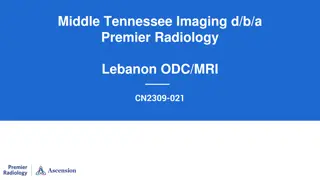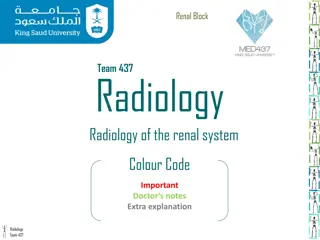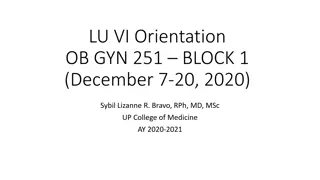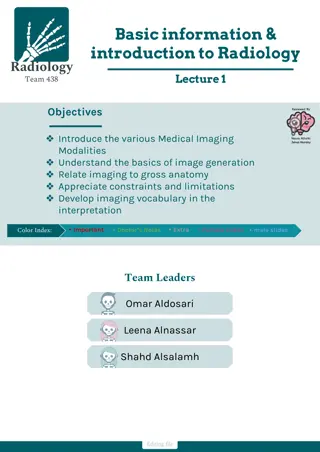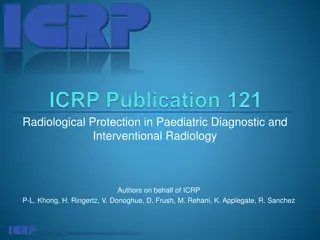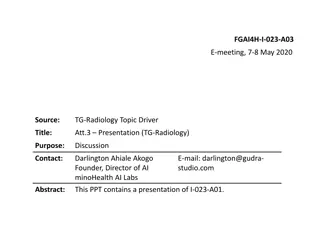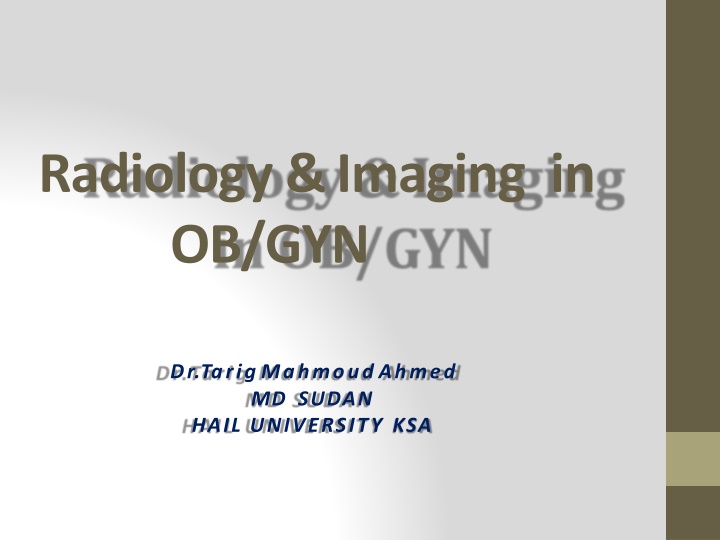
The Role of Ultrasound in OB/GYN Practice
Learn about the benefits of ultrasound imaging in obstetrics and gynecology, including early pregnancy diagnosis, fetal well-being assessment, malformation detection, and chromosomal abnormality screening. Discover how ultrasound measurements aid in accurately determining gestational age and growth. Explore the various ultrasound techniques used, such as transabdominal and transvaginal probes, to provide safe and effective diagnostic information.
Download Presentation

Please find below an Image/Link to download the presentation.
The content on the website is provided AS IS for your information and personal use only. It may not be sold, licensed, or shared on other websites without obtaining consent from the author. If you encounter any issues during the download, it is possible that the publisher has removed the file from their server.
You are allowed to download the files provided on this website for personal or commercial use, subject to the condition that they are used lawfully. All files are the property of their respective owners.
The content on the website is provided AS IS for your information and personal use only. It may not be sold, licensed, or shared on other websites without obtaining consent from the author.
E N D
Presentation Transcript
Radiology & Imaging in OB/GYN Dr.Tarig Mahmoud Ahmed MD SUDAN HAIL UNIVERSITY KSA
ultrasound in obstetric practice The ultrasound technique uses very high frequency sound waves of between 3.5 and 7.0 mega hertz. Ultrasound scanning is currently considered to be a safe, non-invasive, accurate and cost- effective investigation in the fetus. Tow types: 1) Transabdominal. 2) Transvaginal.
Advantage of ultra sound Diagnosis and confirmation of viability in early pregnancy: The gestational sac can be visualized from as early as 4 5 weeks of gestation and the yolk sac at about 5 weeks . The embryo can be observed and measured at 5 6 weeks gestation. A visible heartbeat can be visualized by about 6 weeks.
Assessment of fetal well-being: The use of Doppler ultrasound allows the assessment of the velocity of blood within fetal and placental vessels and provides indirect assessment of fetal and placental condition.
Detect malformations in the fetus: Major structural abnormalities occur in 2 3 % of pregnancies and many can be diagnosed by an ultrasound scan at around or before 20 weeks gestation. Common examples include spina bifida and hydrocephalus, skeletal abnormalities such as achondroplasia, abdominal wall defects such as exomphalos and gastroschisis, cleft lip/palate and congenital cardiac abnormalities.
First trimester ultrasonic soft markers for chromosomal abnormalities such as the absence of fetal nasal bone, an increased fetal nuchal translucency are now in common use to detect fetuses at risk of chromosomal anomalies such as Down s syndrome.
measurements can be made accurately (gestational age, size and growth): The crown-rump length (CRL) is used up to 13 weeks + 6 days, and the head circumference (HC) from 14 to 20 weeks gestation. The biparietal diameter (BPD) and femur length (FL) can also be used to determine gestational age.
Essentially, the earlier the measurement is made, the more accurate the prediction so CRL (accuracy of prediction 5 days) will be preferred to a biparietal diameter at 20 weeks (accuracy of prediction 7 days). Gestational age can not be accurately calculated by ultrasound after 20 weeks gestation because of the wider range of normal values of AC and HC around the mean.
In addition to AC and HC, BPD and FL, when combined in an equation, provide a more accurate estimate of fetal weight (EFW). In (FGR) pregnancies is helpful in distinguishing between different types of growth restriction (symmetrical and asymmetrical).
crown-rump length (CRL) Biparietal diameter (BPD)
Femur length (FL) Abdominal circumference (AC)
Placental localization: ultrasonographic identification of the lower edge of the placenta to exclude or confirm placenta praevia as a cause for antepartum haemorrhage is now a part of routine clinical practice. At the 20 weeks scan, it is customary to identify women who have a low-lying placenta.
Amniotic fluid volume assessment: Ultrasound can be used to identify both increased and decreased amniotic fluid volumes. The maximum vertical pool is measured after a general survey of the uterine contents. Measurements of less than 2 cm suggest oligohydramnios, and measurements of greater than 8 cm suggest polyhydramnios.
The Amniotic Fluid Index (AFI) is measured by dividing the uterus into four quadrants. A vertical measurement is taken of the deepest cord free pool in each quadrant and the results summated. It should be between 10 and 25 cm; values below 10 cm indicate a reduced volume and those below 5 cm indicate oligohydramnios, while values above 25 cm indicate polyhydramnios.
anencephaly or oesophageal atresia, will result in an increase in amniotic fluid. Renal agenesis and posterior urethral valves, will result in reduced or absent amniotic fluid.
Detect number of fetuses and chorionicity: It is clinically useful to determine chorionicity early in pregnancy , Twins and higher multiple gestations. In the first trimester placental tissue is seen within the base of dichorionic membranes and has been termed the twin peak or lambda sign.
Measurement of cervical length: Evidence suggests that approximately 50 per cent of women who deliver before 34 weeks gestation will have a short cervix. The length of the cervix can be assessed using transvaginal scanning.
Invasive procedures: Ultrasound is used to guide invasive diagnostic procedures such as amniocentesis, chorion villus sampling.
Other uses: Ultrasonography is also of value in other obstetric conditions such as: confirmation of intrauterine death. confirmation of fetal presentation in uncertain cases. diagnosis of fetal gender. diagnosis of uterine and pelvic abnormalities during pregnancy, for example fibromyomata and ovarian cysts.
Magnetic resonance imaging MRI provides multiplanar views, better characterization of anatomic details of, for example, the fetal brain, and information for planning the mode of delivery and airway management at birth.
ultrasound in In gynecological practice Mullerian agenesis: Rokitansky syndrome measurements of ovarian volume, mean ovarian diameter and antral follicle count to calculate ovarian reserve and follicular tracking. pelvic mass symptoms suggest an endometrial polyp.
Detect endometriomas or appearances suggestive of adenomyosis and endometrial thickness. ectopic pregnancy miscarriage Gestational trophoblastic disorder: ( snow storm in molar pregnancy) Post-micturition urine residual estimation in urogynaecology.
MRI MRI can detect lesions >5 mm in size, particularly in deep tissues. amenorrhoea with Pituitary adenoma. can diagnose adenomyosis pre-surgery. endometrial tumours staging.
CT scan Diagnose ovarian tumours. assessment of the liver and lymph nodes.
x-ray vital to exclude lung metastases. hysterosalpingogram HSG.

